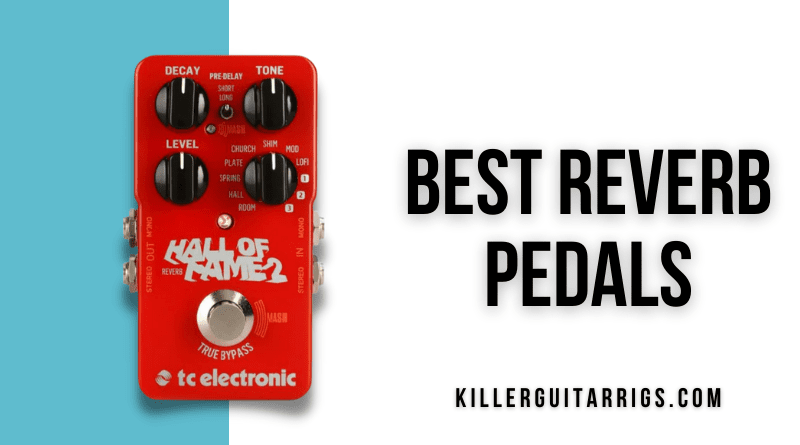Finding a great reverb pedal can be confusing since there are so many types – room, hall, spring, analog, digital, and much more. So we’re cutting through the clutter to find the best options for your needs.
In this KGR guide, we’ve reviewed the 7 Best Reverb Pedals available today. We tested a variety to arrive at this list, to help you avoid any confusion and make an informed decision.
In our tests, we used the same gear for all the pedals to keep things as consistent as possible. We used a Fender Stratocaster guitar and a Fender Champion 20W amp with a stock speaker. We tested the reverb pedals with all their presets and modes, and compared similar reverb modes side-by-side for sound quality. They were judged based on their reverb sound, versatility, ease of use, and build quality.
Read more about our review process.
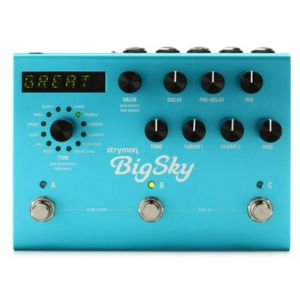
Strymon BigSky
Features: 12 Reverb types, 3 Footswitches, Editable FX
Benefits: Unparalleled reverb quality, Delivers truly unique textures, Studio grade sound
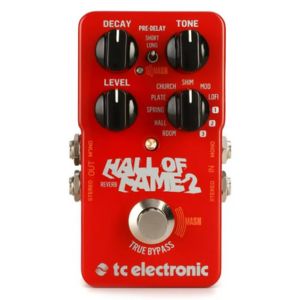
TC Electronic Hall of Fame
Features: Shimmer reverb, 3 Custom reverb slots, Pressure sensitive footswitch
Benefits: Not limited to presets, Preserves signal strength, Hands free parameter adjustmet
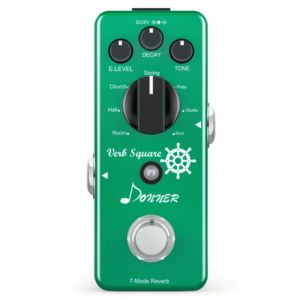
Donner Verb Square
Features: 7 Rerverb types, Metal housing, True bypass
Benefits: Simple operation, Extremely durable, Versatile range of effects
Contents
- Strymon BigSky
- TC Electronic Hall of Fame
- Donner Verb Square
- Our Top 3
- Individual Reviews
- TC Electronic Hall of Fame 2 Reverb Pedal – Our Top Pick
- Donner Verb Square Reverb Pedal – Best Budget Option
- Strymon BigSky Multidimensional Reverb Pedal – KGR Editor’s Choice
- Walrus Audio Slö Multi Texture Reverb Pedal
- Electro Harmonix Oceans 11 Reverb Pedal
- Boss RV-6 Reverb Pedal
- Keeley Caverns V2 Delay and Reverb Pedal
- How to Choose the Right Pedal For You
- Final Thoughts
Our Top 3
- The TC Electronic Hall of Fame 2 Reverb Pedal is our Top Pick, with a great sound and a lot of functionality packed into a compact unit.
- The Donner Verb Square Reverb Pedal is the Best Budget option, delivering great quality at a very reasonable price.
- And the Strymon BigSky Multidimensional Reverb Pedal is our Editor’s Choice. It offers a complete reverb solution capable of creating fantastic soundscapes.
Individual Reviews
TC Electronic Hall of Fame 2 Reverb Pedal – Our Top Pick

A versatile reverb pedal with brilliant shimmering tones.
TC Electronic’s Hall of Fame 2 has new features, adding to the excellent reverb algorithm of the original. We found that the algorithm was initially derived from the TC Electronic SYSTEM 6000, a flagship sound-engineering solution that includes multi-effects processing, audio effects, and plugins used by professionals.
We really liked the addition of the Shimmer setting, which was missing from the original Hall of Fame. This effect is based on the Octave engine from the Sub ‘n’ Up pedal. Including the new effect, we counted a total of eight reverb effects: Room, Hall, Spring, Plate, Church, Shim (Shimmer), Mod (Modulation), and LoFi.
In our opinion, the Hall of Fame 2 has the edge over its competition courtesy of its pressure-sensitive MASH switch and superior algorithms. We found that the footswitch is not just for bypassing the pedal; you can use it to manipulate the reverb in real-time by gradually pressing harder or softer. The MASH switch is entirely customizable, with up to three adjustable parameters, giving you the freedom to alter your sound on the go.
We were also able to edit the MASH switch parameters using the TonePrint Editor. You can assign anything to the footswitch, including reverb space, time, mix level, and dry/wet. We were able to shape the output graph of the pedal to our liking and found that it really sat well in a mix. And we also found some great artist presets online, which were easy to download onto the pedal.
Next, we turned our attention to the vibrantly-colored interface. There are a total of four knobs, a footswitch, and a second small switch for adjusting the pre-delay length (short or long). One knob is for selecting one of the eight effects, and there are three others for editing the reverb parameters – level, decay, and tone.
The Hall of Fame 2 runs on a 9-Volt DC power supply. It has one set of ¼” mono and another set of ¼” stereo inputs and outputs. We also noticed a Mini-B USB slot for connecting to your devices for editing in TonePrint. The entire frame is made of durable cast aluminum, and we feel the knobs are sturdy for prolonged use.
Verdict: The TC Electronic Hall of Fame 2 Reverb Pedal offers a versatile group of effects. We liked the sounds and the new improvements over the first version, with the new mode and pressure-sensitive MASH switch. We found the build quality of the model to be excellent, while the specifications, input and output slots, and pedal size are just right.
Donner Verb Square Reverb Pedal – Best Budget Option
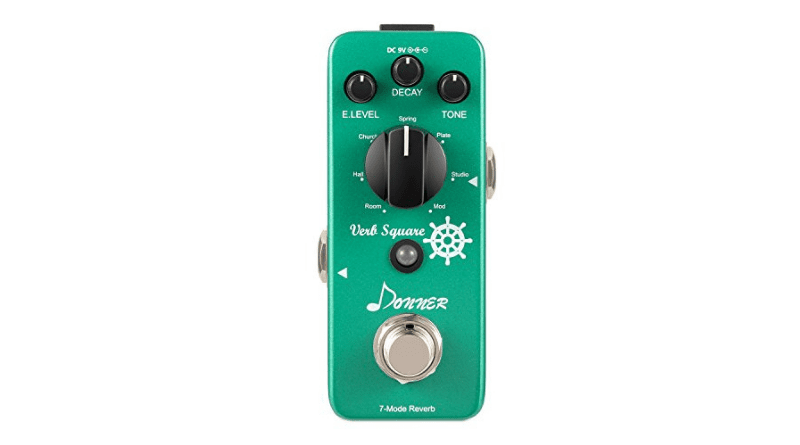
The Verb Square is simple, compact, and powerful.
We recommend the Donner Verb Square if you’re looking for a budget reverb pedal to spice up your tone with a subtle reverb effect. You can get one of these for right around $50. The Verb Square is one of the simplest reverb pedals we’ve come across in terms of features, but it still delivers seven different modes: Spring, Plate, Studio, Modulation, Room, Hall, and Church.
When we tested the Verb Square, we found its reverb sound wasn’t on par with the better options we’ve seen, but the onboard features and functionality make up for it. Aside from the versatility added by the seven different settings, we also liked how compact the design is. The Verb Square hardly takes any space on your pedalboard, which is a pattern we’ve seen with Donner pedals.
The body is colored a vibrant green, and the interface includes three controls for shaping the reverb – tone, level, and decay. There is a large knob for switching between the available modes, a single LED to indicate power, and a footswitch. We found the solid metal body was durable enough and would be suitable for live gigs, while the plastic control knobs did feel a bit flimsy.
We were surprised to see that the pedal does not come with the required 9-Volt DC power supply, and there is no space in the body for a battery. So you will need to get a power supply separately if you buy this pedal. Still, even with the cost of the power supply factored in, the Verb Square is an affordable reverb pedal that’s great for beginners.
Verdict: The Donner Verb Square is an affordable and versatile choice for any guitarist looking for a subtle and straightforward reverb. We were impressed by the inclusion of seven reverb types at the price point. We also found the pedal to be durable, except for the plastic knobs. Just note that you need a 9-Volt DC power supply and that there are no battery slots.
Strymon BigSky Multidimensional Reverb Pedal – KGR Editor’s Choice
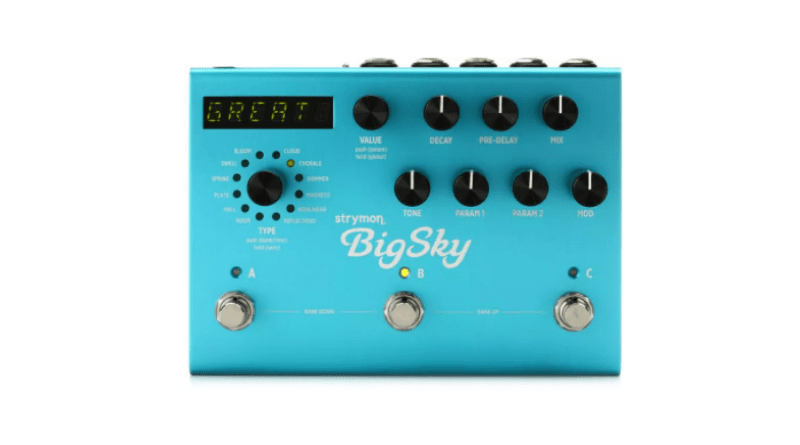
The BigSky is a complete multi-reverb package with incredibly ethereal sounds.
The Strymon BigSky is a flagship multi-reverb pedal. We were amazed by all 12 of BigSky’s reverb modes and the customizability of each setting. BigSky is much more than a single pedal – it has three footswitches that correspond to different settings you can keep as quick-access presets during live performances.
We found that setting up a beautiful reverb on BigSky is far more intuitive than most smaller models. First, we selected a mode from the following – Cloud, Chorale, Shimmer, Magneto Nonlinear, Reflections, Room, Hall, Plate, Spring, Swell, and Bloom. Next, we used the parameters to hone in on the tone we needed.
We noticed the BigSky is based on the SHARC DSP engine, which ensures the best sound quality possible. There is space for 300 presets, which you can save and access instantly during your performances. The knobs on the top right are for setting mix, pre-delay, decay, modulation, and tone. There are also knobs for parameters 1 and 2, which we were able to program to control any characteristic of the reverb tone.
The Value knob controls everything else; the presets, specific parameters, and more. Another feature we found remarkable was the extensive I/O capability of the BigSky. There are a pair of stereo inputs and outputs for your guitar or any other instrument. We tried a synthesizer with this pedal, and it worked just as well. There is an expression pedal input, a switch for the cab filter, and MIDI input/output.
We liked the robust feel of the anodized-aluminum body, along with the sturdy knobs and switches. As the name suggests, the body is sky-blue, and we think the interface is well thought out with its neon-green display and indicators for use on a dark stage. The pedal is rather large, which may be the only limitation if you already have a crowded pedalboard.
Verdict: The Strymon BigSky is simply one of the best reverb pedals on the market. In our tests, it provided quality and flexibility with reverbs of every type. We found the build quality to be impressive and reassuring. The only drawbacks for this pedal are its price and relatively large size.
Walrus Audio Slö Multi Texture Reverb Pedal

A uniquely atmospheric reverb pedal with brilliant textures.
The Walrus Audio Slö Multi Texture is one of our favorite reverb pedals, despite not having the numerous reverb modes that we generally see in these pedals. It trades versatility for uniqueness to give us three breathtaking reverb types, each with great customizability. There are also three modulation settings for the reverb, giving more depth to the tone than standard pedals.
Aside from the usual Decay, Mix, Depth, and Filter (EQ) settings we saw in all the other pedals we tested, the Slö has an extra setting called X, which is a unique parameter for each of the three modes. The three modes can be set using the switch in the top center – Dark, Rise, and Dream.
We found that Dark adds another reverb on top of the original, but an octave lower. Rise is a reverb that swells as it goes, while Dream has a latch function for activating infinite reverb at any point when you press the sustain switch. For Dark and Rise, we found that the sustain switch ramps up the decay setting to full, until we let go.
The same switch that controls the reverb modes also controls the modulation settings when the bypass switch is held. The modulation settings are Sine, Warp, and Sink, so you get three waveforms. We were able to control the speed of the modulation with the depth knob.
The X knob controls the level of the lower-octave reverb in the case of Dark, Rise sets the delay before the swell effect, and Dream sets the depth of the vibrato associated with the reverb.
In our opinion, the build quality and looks of the Slö are excellent. The deep-colored body is beautiful and sturdy, while the knobs feel great. Slö does not come with the required 9-Volt power supply, and it is not compatible with batteries.
Verdict: The Walrus Audio Slö Multi Texture Reverb Pedal is a beautifully crafted pedal that offers some of the most unique, deep, and dark reverb tones we’ve heard. It offers a great degree of customizability even with its limited number of control knobs. The build quality of the pedal is fantastic. However, Slö does lack the standard reverb types commonly found on pedals, so it’s better suited if you need an experimental reverb tone.
Electro Harmonix Oceans 11 Reverb Pedal
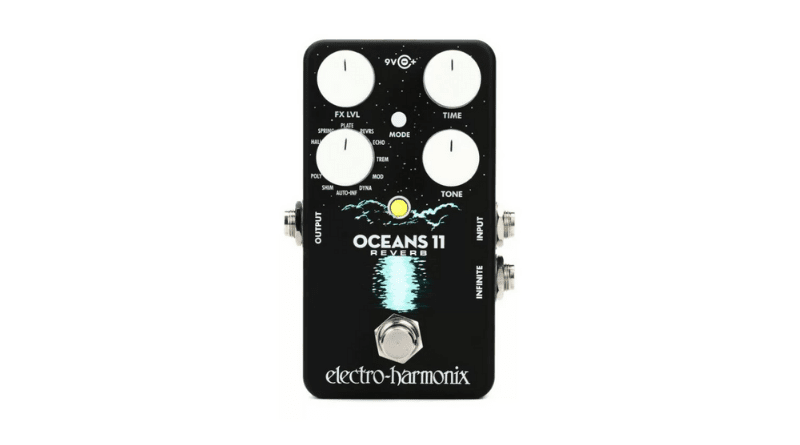
A versatile reverb pedal with both standard and exotic tones.
The Electro Harmonix Oceans 11 is an incredibly versatile pedal that goes far beyond the 11 modes you see on its interface. In our tests, we were able to find lots of interesting features among particular settings that are not apparent at first glance.
The controls on the Oceans 11 appear to be the same as other reverb pedals, with three knobs for controlling the level, tone, and decay of the reverb and one knob for the 11 different modes. The pedal features classic reverbs like Hall, Plate, Spring, Mod (modulation), Echo, and Shimmer. We also loved trying out the more unique inclusions such as the Reverse, Trem, Dynamic, Poly, and Auto-Infinity modes.
The Reverse mode adds a cool inverted reverb that helps add space to ambient cleans. The Trem reverb is a combination of tremolo and reverb. We found the tremolo waveform (Sine, Square, and Triangle) can be chosen using the mode button. In Trem mode, we set the speed of the effect to the max to get a ring modulation effect.
The Spring reverb is based on the renowned Fender Spring Reverb Tank and it is our favorite effect. In Spring mode, we found that double-tapping the footswitch creates the noise you would expect from a real spring reverb amp when you move it around, which gives a tad more authenticity to the effect.
The Dynamic mode has three settings: Swell, Gate, and Ducking. Other reverb modes also have multiple functionalities, such as Poly and Mod. Additionally, there’s an infinite-reverb setting, as well as the option to connect a switch for freezing a particular note while you continue to play.
We felt the design of the Oceans 11 is impressive with its black aluminum body, white knobs, and the central mode button. The required 9-Volt DC power supply comes with the pedal and the body is pretty compact, so it should fit on any standard pedalboard. But it isn’t compatible with batteries.
Overall, this reverb pedal packs a lot of power, and there’s a big tonal playground here. All the modes and features have unique additions that spice up your tone.
Verdict: The Electro Harmonix Oceans 11 is one of the most versatile small-sized pedals we have reviewed. You can create a variety of quality reverb sounds on it, along with some interesting real-time expression features. It is also very affordable compared to flagship reverb pedals. The hidden settings are a fun and challenging way to experiment with the reverb further.
Boss RV-6 Reverb Pedal
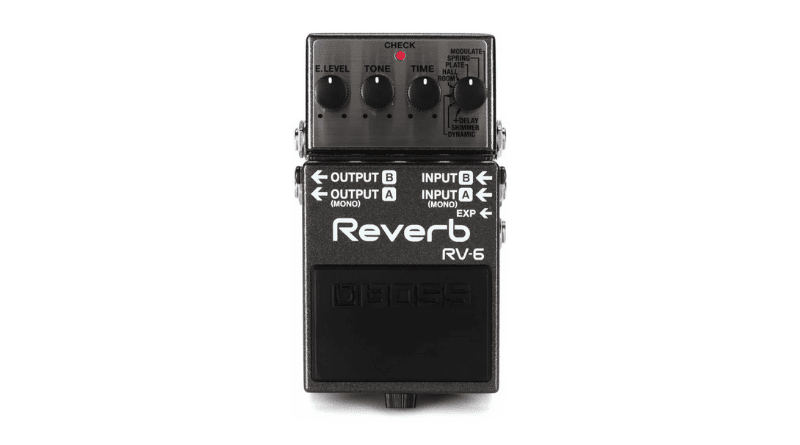
A roadworthy reverb pedal with a renowned pedigree.
The Boss RV series has long been a favorite of guitarists due to its reliability and functionality. The RV-6 is the newest release and comes with all the features of previous models, along with some new additions.
The interface of the RV-6 has three standard controls for the reverb settings – Level, Tone, and Time, along with one knob for changing the reverb mode. There are 8 different reverb modes – Modulate, Spring, Plate, Hall, Room, Dynamic, Shimmer, and +Delay.
We found the standard modes work well, while the Dynamic and Delay modes are new. During our tests we found the Dynamic mode to be the most interesting; the reverb responds to your playing and varies in intensity depending on how hard you pick the strings. The +Delay is another feature we found very useful, as it combines delay and reverb effects, eliminating the need for a separate delay pedal.
The RV-6 has an impressive I/O as it supports both stereo and mono inputs. We experimented with the inputs and found the top jack (B input) controls the wet signal input, so you can isolate the wet signal. And we also tested the expression pedal jack, which allowed us to control the reverb intensity in real-time.
What we loved with the RV-6 is that it continues Boss’ rugged design principles for a really durable pedal. These pedals should last for decades, even with a good amount of use. The body is all metal with a large, boxy pedal design that’s much more reliable and comfortable to use than a footswitch, and the knobs feel nice and sturdy. This pedal does not come with the required 9V power supply, but you can use it with a 9V battery.
Verdict: The Boss RV-6 is a well-rounded and durable pedal with some really interesting effects along with the more standard reverb types and settings. The range of I/O makes it perfect for complex rigs as well. We recommend this pedal for anyone looking for a standard reverb pedal that they will use for years, both on the go and at home.
Keeley Caverns V2 Delay and Reverb Pedal
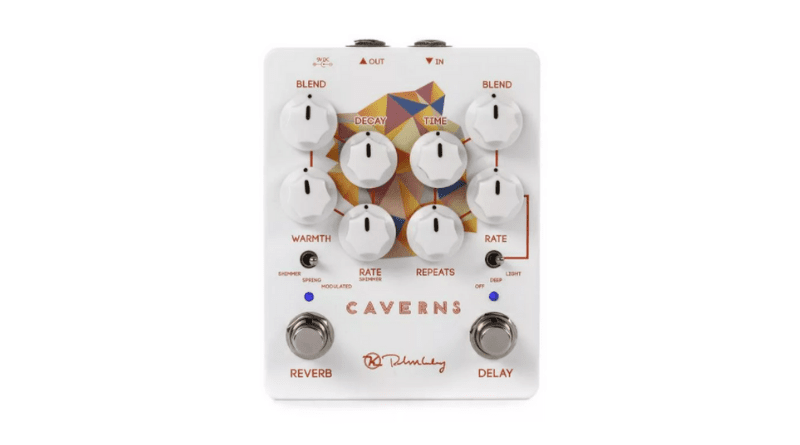
The Caverns V2 marries warm reverb with a rich delay.
The Keeley Caverns V2 is a two-in-one pedal with distinct footswitches for both the reverb and delay effects. We love the clear separation between the two effects, with the left half of the pedal dedicated to the reverb and the right half to the delay. We found this makes it really easy to use both the effects together on a single pedal, taking up less space on our pedalboard.
On the reverb side, we observed three basic controls for the reverb – Blend (level), Warmth (tone), and Decay (time). There is a fourth control, the Rate, which controls different things in different modes. There are three modes in total – Shimmer, Spring, and Modulated.
In Shimmer mode, the Rate knob controls the number of octave trails generated by the reverb, while in Spring mode, it controls the rate of the tremolo. And in Modulated, it controls the speed of the modulation.
The delay effect is tape-styled and also has four controls and three modes, but here we saw a major difference. The different modes are not separate types of delay, but are rather modulation add-ons – Light, Deep, and Off modes are available. The knobs control Blend (level), Time, Repeats, and Rate.
We love the inclusion of separate footswitches for the two effects. The inclusion of the I/O at the top of the pedal allows for vertical positioning, saving even more space on your board. The build is robust and looks great, plus there’s a switch to toggle between true bypass or buffered bypass (which activates Trails mode) as well.
Verdict: The Keeley Caverns V2 provides two effects in one convenient package. Both the delay and reverb are simple and don’t offer a lot of modes, but they sound incredible and have some nifty features as well. This pedal is perfect if you need to save space on your pedalboard, but not ideal if you’re looking to modify every aspect of your tone.
How to Choose the Right Pedal For You
With so many options, reverb types, and features, choosing a reverb pedal is very confusing if you don’t know what to look for. Here are the most important things to consider when buying a reverb pedal:
- Build Quality is very important for any pedal, as it will have to take the stresses of gigging and years to use. Even if the body is solid, sometimes the knobs are not good enough for extended use. On the other hand, if you only plan to use it at home, you can consider a pedal that’s less durable.
- Noise can be a turnoff in many cases. Good quality pedals will usually make very negligible noise. Noise can be eliminated in post-processing, but it is just easier for both production and live performances to have good-quality pedals with low-noise. This is especially true for high-gain setups.
- Power is an important factor – whether you already have a power supply compatible with the pedal or you’ll need to buy one. Some reverb pedals can use batteries, but many don’t.
- Size and support are also very important. If you don’t have enough space on your pedalboard for a multi-effects unit, you may have to settle for a smaller one. Adjusting your pedalboard accordingly can be a bit of a challenge.
- Price – With reverb pedals, we’ve seen that price often directly correlates to the quality of the reverb sound. Between the Donner and the Strymon, there’s a clear difference in sound quality, as well as the versatility.
The question of which reverb pedal to buy ultimately comes down to taste and playing style. Some pedals have a more subtle reverb effect, which may be your best bet if you play mostly overdriven tones. For clean tones, reverb becomes a very significant factor. So if you play softer genres with ambient sounds, a good reverb pedal might become your best friend.
A lot of reverb pedals, including most that we featured, come with a number of reverb effects, which makes them very versatile. If you are just starting out, or if you often play many different genres, multiple reverb modes such as Church, Room, Plate, Spring, Hall, Modulation, Shimmer, etc. will likely come in handy for different songs and performances.
If you have been playing guitar for a while and you know exactly what you are looking for, go with the more specialized pedals, like the Walrus Audio Slö. These pedals have very unique and customizable effects that make them invaluable to experienced producers who know how to make use of them.
The best way to decide is to try out pedals yourself at a local guitar store. If that’s not an option, online gear demos do help you test with your own ears and see what sounds good to you.
Remember, the tone is subjective. As long as it sounds good to you, that’s really all that matters.
Final Thoughts
In summary, our Best Value pick for reverb pedals is the versatile TC Electronics Hall of Fame 2. Our Best Budget pick is the Donner Verb Square, and our Editor’s Choice is the Strymon BigSky, one of the best reverb pedals ever created.
Reverb has been a widely-used effect among guitarists for more than half a century. It’s essential to most tones, and choosing the right pedals can make all the difference.

